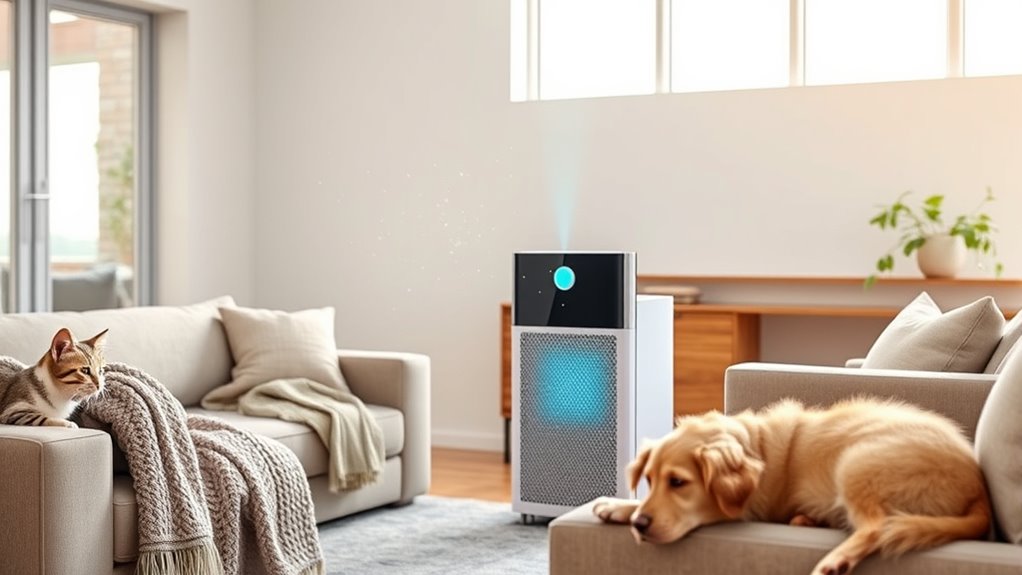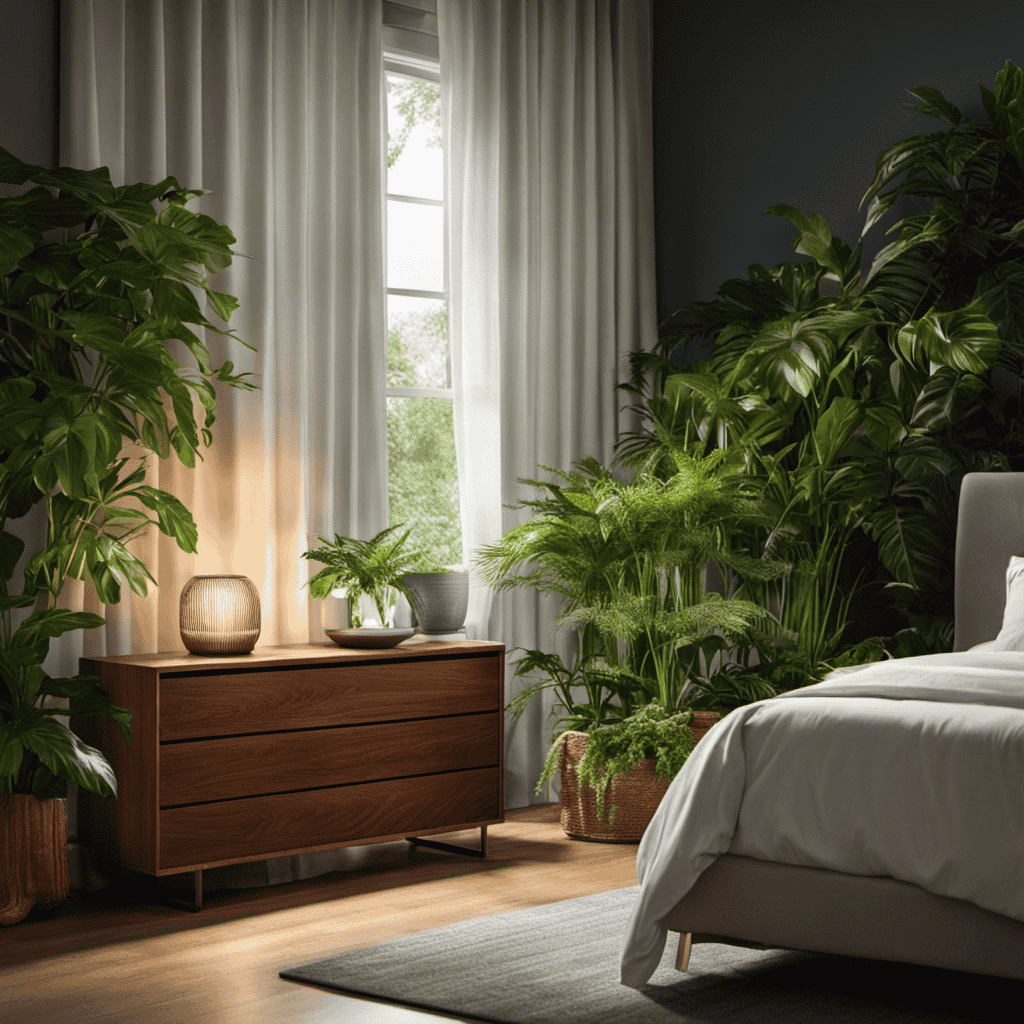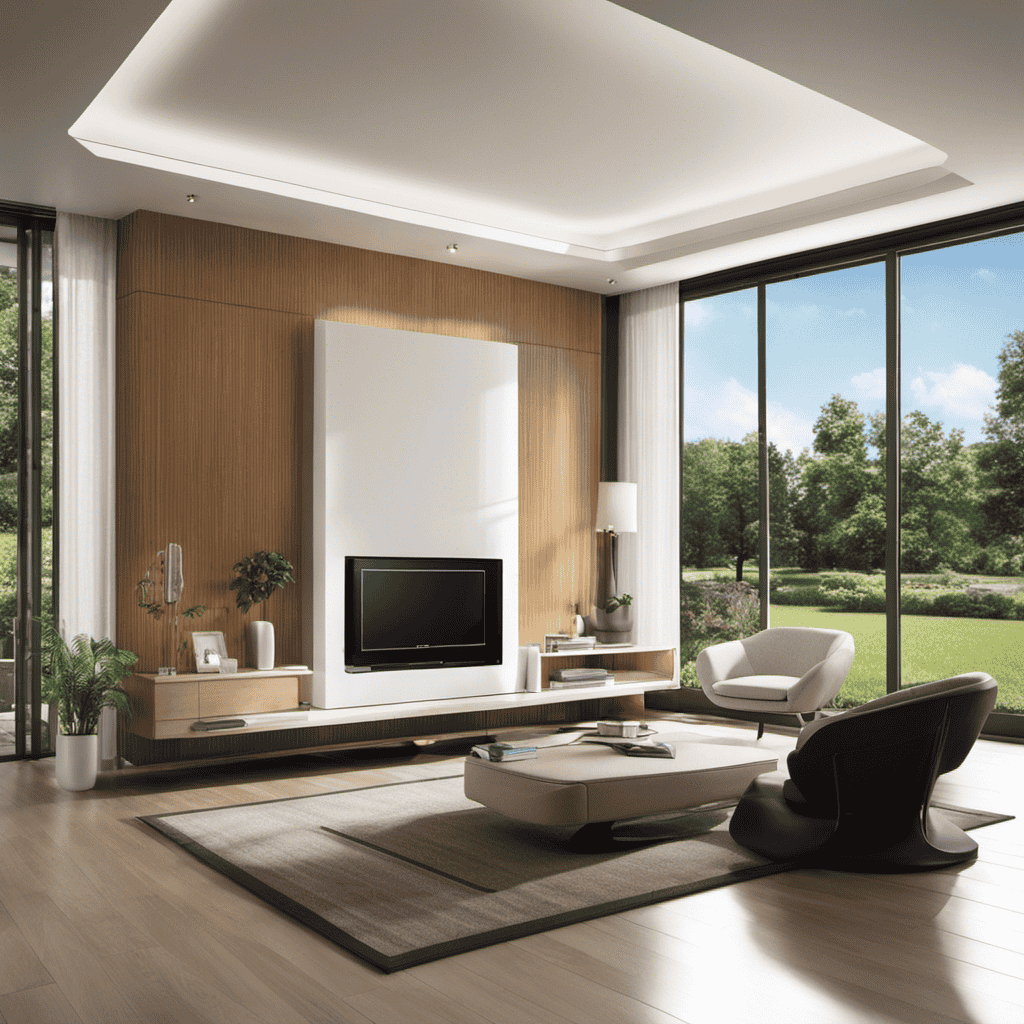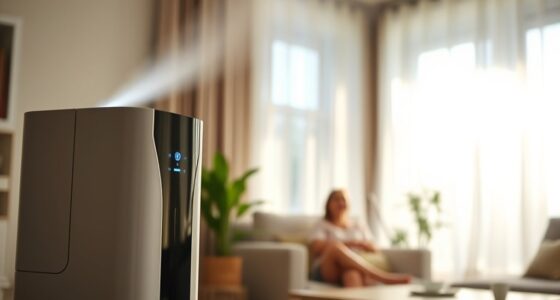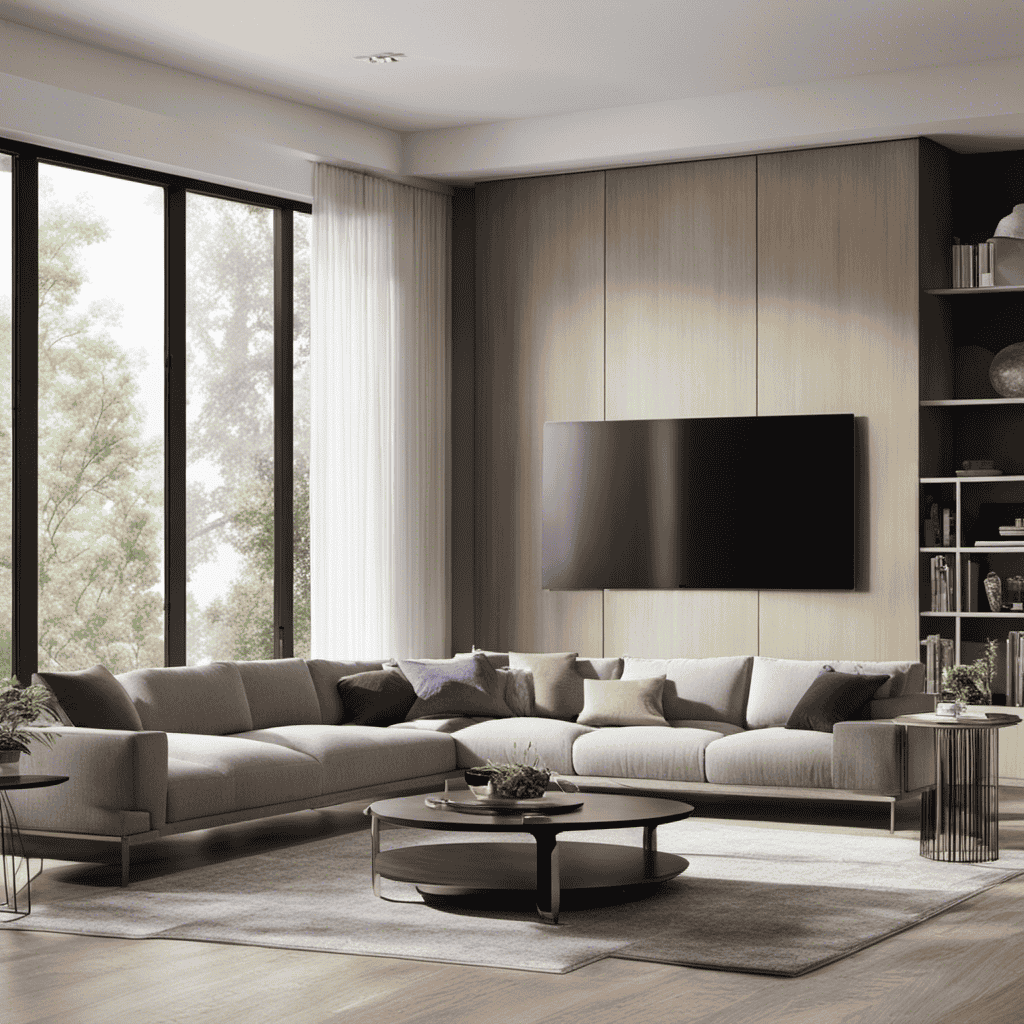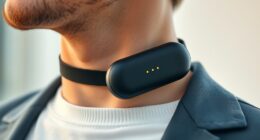To manage pet allergies with an air purifier, choose one with a HEPA filter that captures tiny pet dander, saliva, and hair particles effectively. Place it near pet areas and run it consistently during active times to reduce airborne allergens. Regularly maintain the filter and combine use with pet grooming and good ventilation for best results. Keep exploring to find out how different features and practices can further improve your indoor air quality.
Key Takeaways
- HEPA air purifiers effectively capture pet dander, reducing airborne allergens and alleviating allergy symptoms.
- Proper placement and sizing of air purifiers maximize their ability to remove pet allergens in living spaces.
- Regular filter maintenance ensures continuous removal of pet hair, dander, and other allergens from indoor air.
- Combining air purifiers with pet grooming and good ventilation enhances overall allergen control.
- Using air purifiers can decrease reliance on allergy medications and improve indoor air quality for pet allergy sufferers.
Understanding Pet Dander and Its Impact on Allergies
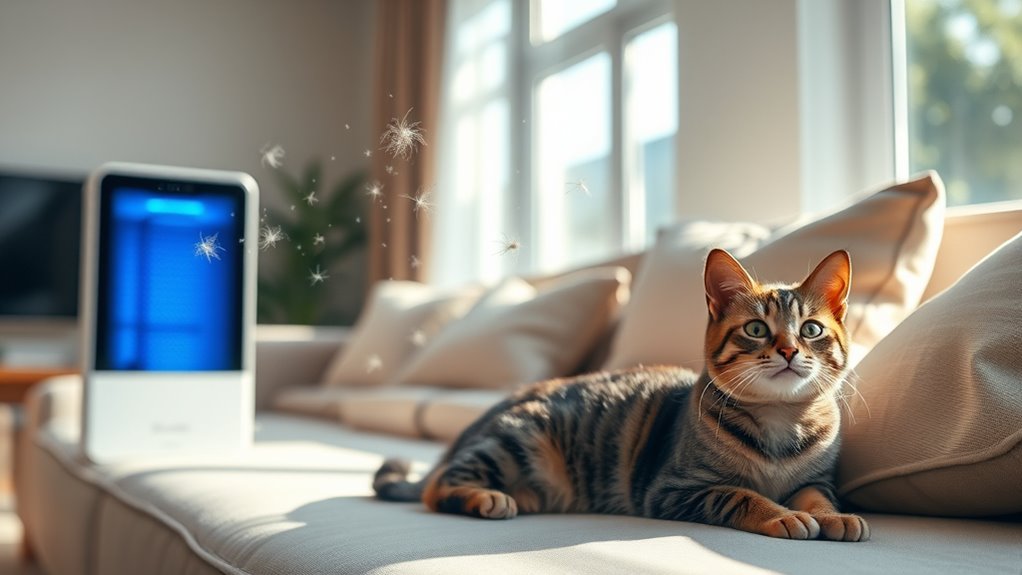
Have you ever wondered what triggers your pet allergy symptoms? It’s often pet hair and saliva allergens that cause the biggest problems. Pet hair carries tiny dander particles, which are skin flakes that pets shed constantly. These skin flakes contain proteins that are highly allergenic. Saliva allergens also play a significant role; when your pet licks itself, proteins from saliva stick to fur and skin, eventually becoming airborne or settling on surfaces. These allergens can cling to furniture, clothing, and carpets, making it hard to avoid exposure. Understanding that pet hair and saliva allergens are key triggers helps you grasp why allergies persist even if your pet is not in the room. Recognizing this connection is the first step toward managing your allergy symptoms effectively.
How Air Purifiers Help Reduce Pet Dander in Indoor Spaces
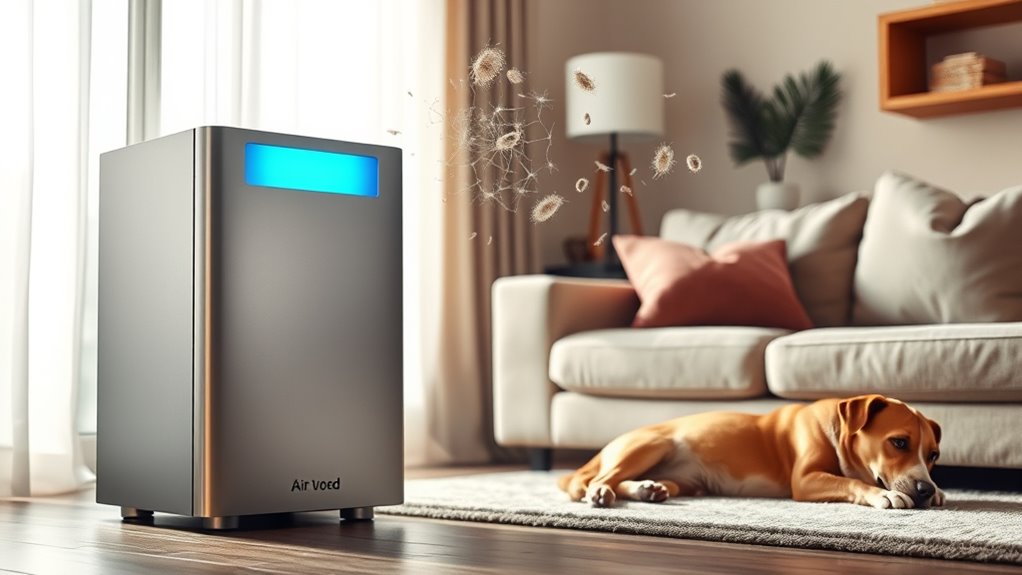
Air purifiers with HEPA filters are highly effective at capturing pet dander particles, reducing allergens in your home. They improve air circulation, ensuring cleaner air reaches all corners of your space. By trapping allergen particles, these devices help create a healthier indoor environment for allergy sufferers. Additionally, some models feature auto functions that adjust fan speed based on air quality readings to optimize pet dander removal. Using a device with certified filtration can further enhance the efficiency of allergen removal. Many explorers highlight the importance of resilience in overcoming challenges during their journeys, a trait that can also be beneficial when managing household allergens. Incorporating advanced filtration technology can significantly boost allergy relief efforts.
HEPA Filtration Effectiveness
HEPA filters are highly effective at capturing pet dander, making air purifiers a valuable tool for reducing allergens indoors. These filters trap tiny particles, including pet dander, pollen, and dust mites, notably improving air quality. To maintain peak performance, you’ll need to replace filters regularly; neglecting filter replacement can reduce filtration efficiency. While HEPA filters excel at removing allergens, some units may produce noticeable noise levels, especially on higher settings. If noise bothers you, consider models designed for quiet operation or adjustable fan speeds. Properly maintained HEPA filters ensure consistent allergen removal, helping you breathe easier and minimize allergy symptoms. Additionally, filter replacement frequency is crucial for ongoing effectiveness, typically recommended every 6-12 months depending on usage. Regularly inspecting your air purifier and filter lifespan helps ensure it continues to operate at optimal capacity. Choosing a purifier with advanced filtration technologies can further enhance allergen capture and improve overall air quality. Staying informed about air quality standards can guide you in selecting the most effective purifier for your needs. By choosing the right purifier and keeping up with filter replacement, you maximize HEPA filtration’s effectiveness in your indoor environment.
Air Circulation Improvement
Effective air circulation plays a key role in reducing pet dander indoors. Proper airflow dynamics ensure that airborne allergens don’t settle in one area, making your air purifier more effective. Ventilation systems work alongside purifiers to move stale, allergen-laden air out and draw in fresh air, preventing pet dander buildup. When air circulates well, pet dander doesn’t accumulate in corners or on surfaces, reducing your exposure. Using ceiling fans or exhaust fans can enhance this process, helping to maintain a consistent flow of clean air. Keep doors open and avoid stagnant air pockets to maximize circulation. By improving air flow dynamics, you create a healthier environment where pet dander is less likely to linger, easing allergy symptoms for you and your family. Additionally, understanding the weight of different machines can help in planning for proper placement and maintenance of air purifiers in your home. Proper air circulation also prevents the buildup of airborne allergens, further reducing allergy symptoms and improving indoor air quality. Ensuring good airflow helps disperse pet dander more evenly and prevents concentrated allergen zones. Regularly inspecting and maintaining your ventilation system can also optimize air circulation, ensuring continuous allergen reduction. Incorporating vertical storage solutions for other household items can help keep surfaces clear and reduce dust and pet dander accumulation.
Allergen Particle Capture
Since pet dander particles are often tiny and lightweight, they can easily remain suspended in the air, making it difficult to remove them through ventilation alone. That’s where air purifiers excel at allergen capture. High-efficiency filters, like HEPA filters, are designed to trap these minuscule dander particles effectively. As air circulates through the purifier, the filters capture allergen particles before they settle on surfaces or are inhaled. This process considerably reduces airborne pet allergens, providing relief for allergy sufferers. Proper allergen capture is vital to maintaining a healthier indoor environment. Using an air purifier with a reliable HEPA filter ensures that even the smallest dander particles are removed from your air, helping you breathe easier and manage pet allergies more effectively. Additionally, understanding Chevrolet Tuning can be a helpful analogy for optimizing your indoor air quality through effective filtration methods. Employing air purifiers with advanced filter technology can further enhance allergen removal efficiency. Incorporating models with auto functionality can help maintain consistent air quality without constant manual adjustments. Furthermore, selecting units with coverage capacity ensures comprehensive purification for larger spaces.
Key Features to Look for in an Air Purifier for Pet Allergies
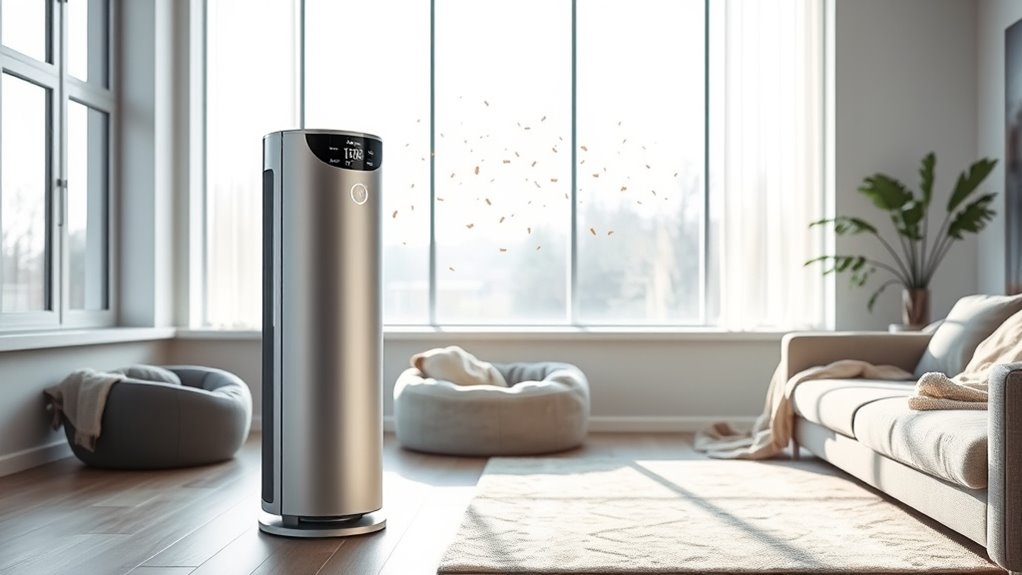
When choosing an air purifier for pet allergies, look for models with high-efficiency filtration to effectively trap pet dander. Make sure the HEPA filter is rated to remove tiny particles, as this is key to improving indoor air quality. Also, check that the purifier’s coverage area matches the size of your space for ideal performance. Incorporating data analytics can help monitor air quality levels over time to ensure your environment remains healthy. Additionally, selecting a unit with a Bluetooth interface can facilitate remote monitoring and control, making it easier to maintain optimal air quality. Exploring cookie management options can also help you understand how your device handles data for smarter operation, all while providing a creative way to manage hair health alongside air quality improvements.
High-Efficiency Filtration
High-efficiency filtration is essential for removing pet dander, hair, and other allergens from the air you breathe. When choosing an air purifier, look for models with advanced filters that trap tiny particles effectively. Regular air purifier maintenance is crucial to keep it working at peak performance, so consider how easy it is to access and replace filters. Proper filter replacement ensures allergens don’t bypass the filtration system, maintaining clean indoor air. Avoid models with cheap or ineffective filters, as they won’t capture all pet allergens. Properly selecting and maintaining your purifier with quality filtration systems reduces airborne dander, making breathing easier and alleviating allergy symptoms. Additionally, understanding air quality can help you choose the most suitable purifier for your environment. Regularly monitoring indoor air quality allows you to adjust your filtration needs and improve overall health. Recognizing airborne allergen levels can further optimize your air purification strategy. Properly selecting and maintaining your purifier is vital for air quality and creating a healthier living environment.
HEPA Filter Effectiveness
Are you choosing the right air purifier to combat pet allergies? HEPA filters are essential because they meet strict HEPA standards, capturing at least 99.97% of airborne particles. To guarantee effectiveness, look for filters with a long filter lifespan, meaning fewer replacements and consistent performance. Key features to consider include:
- Filtration Efficiency: Confirm it meets HEPA standards for maximum dander removal.
- Filter Lifespan: Longer-lasting filters reduce maintenance and maintain air quality over time.
- Replacement Indicators: Alerts help you know when it’s time to change the filter to keep performance at its best.
Choosing an air purifier with a reliable HEPA filter guarantees you’re effectively reducing pet dander and allergens in your space. Additionally, understanding the contrast ratio of your air purifier can help you evaluate its ability to perform well in different lighting conditions, ensuring optimal visibility of indicator lights and displays. Being aware of filter maintenance requirements can also help you maintain consistent air quality and prolong the lifespan of your device.
Coverage Area Size
How much space do you need your air purifier to cover? This is a key question when considering air purifier sizing for pet allergies. The coverage area determines how effectively your purifier can clean the air in your space. Measure the room’s square footage before choosing a unit, guaranteeing the device’s coverage area matches or exceeds your room size. An underpowered purifier won’t effectively filter pet dander, while an oversized one can be unnecessary and costly. Check the manufacturer’s specifications for coverage area, which indicates the maximum square footage the purifier can handle efficiently. Selecting an air purifier with appropriate coverage area ensures you get best air cleaning performance, reducing pet allergens and improving your indoor air quality.
Types of Air Filters Effective Against Pet Dander
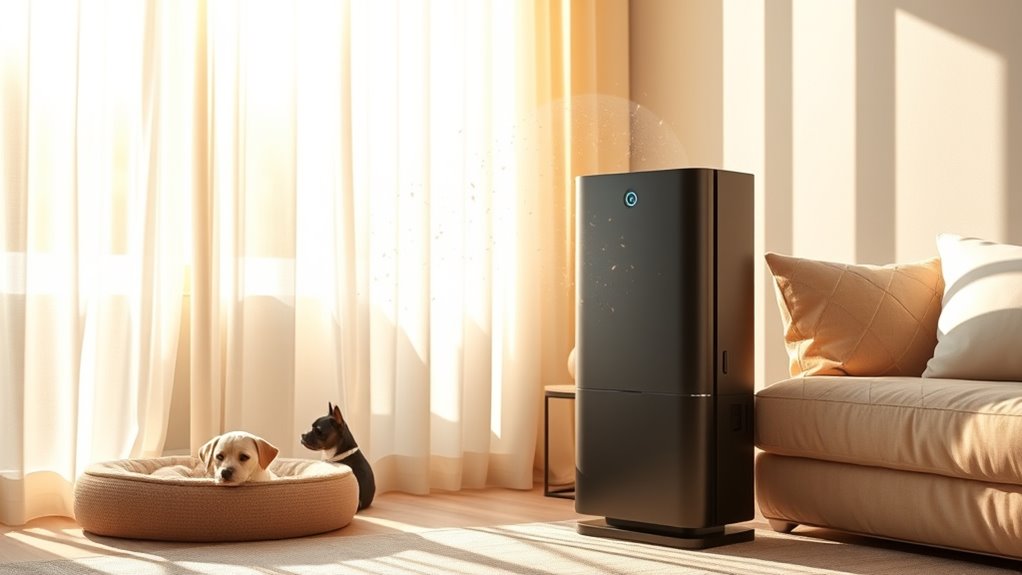
To effectively reduce pet dander in your home, choosing the right air filter is essential. Not all filters are equally effective against allergens. Look for filters with a MERV rating of 11 or higher, which can trap smaller particles like pet dander. Consider these filter types:
- HEPA filters – capture 99.97% of airborne particles, including pet allergens.
- Activated carbon filters – reduce odors and some allergens.
- Electrostatic filters – attract and trap pet dander using static electricity.
Proper Placement and Usage of Air Purifiers in Your Home

Proper placement and usage of air purifiers are key to maximizing their effectiveness in reducing pet dander. Position your air purifier where it can optimize room-specific airflow—near pet areas or main living spaces. Avoid placing it in corners or behind furniture, which can block airflow. Ensure the device is on a stable surface and at least a few inches from walls for better circulation. Use it continuously, especially during pet activity peaks. Consider the following table for strategic placement:
| Location | Benefit | Best Practice |
|---|---|---|
| Living Room | High pet activity | Near center, unobstructed |
| Bedroom | Sleep comfort, allergies | Close to bed, away from walls |
| Entry Points | Prevent spreading pet dander | Near doorways, ventilation vents |
| Pet Areas | Direct dander removal | Close to pet spots |
| Common Spaces | Overall air quality | Central location |
Additional Strategies for Managing Pet Allergies
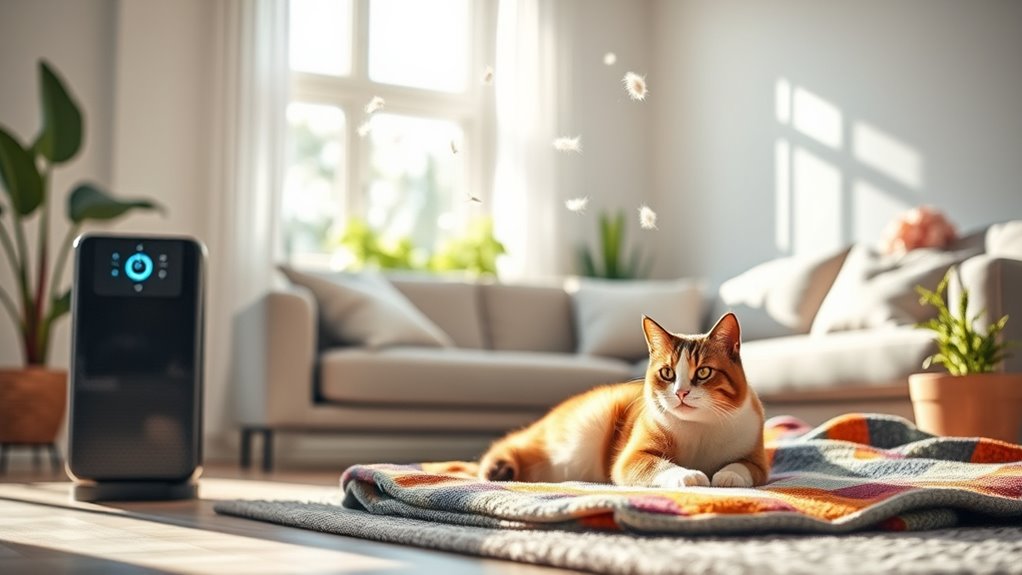
In addition to air purifiers, implementing regular cleaning routines can substantially reduce pet allergens. Regularly vacuum carpets, rugs, and furniture with a HEPA filter to trap dander. Bathe and groom your pet frequently to minimize dander shedding and reduce allergen levels. Also, consider the following strategies:
Regular cleaning and grooming help reduce pet allergens and improve home comfort.
- Pet Grooming: Keep your pet well-groomed to lessen dander spread.
- Allergy Medication: Use antihistamines or other allergy meds as recommended by your doctor to manage symptoms.
- Designated Spaces: Create pet-free zones, especially in bedrooms, to limit allergen exposure where you sleep.
Together, these steps complement air purifiers and help you better manage pet allergies for a more comfortable home.
Comparing Different Air Purifier Models for Pet Dander Control
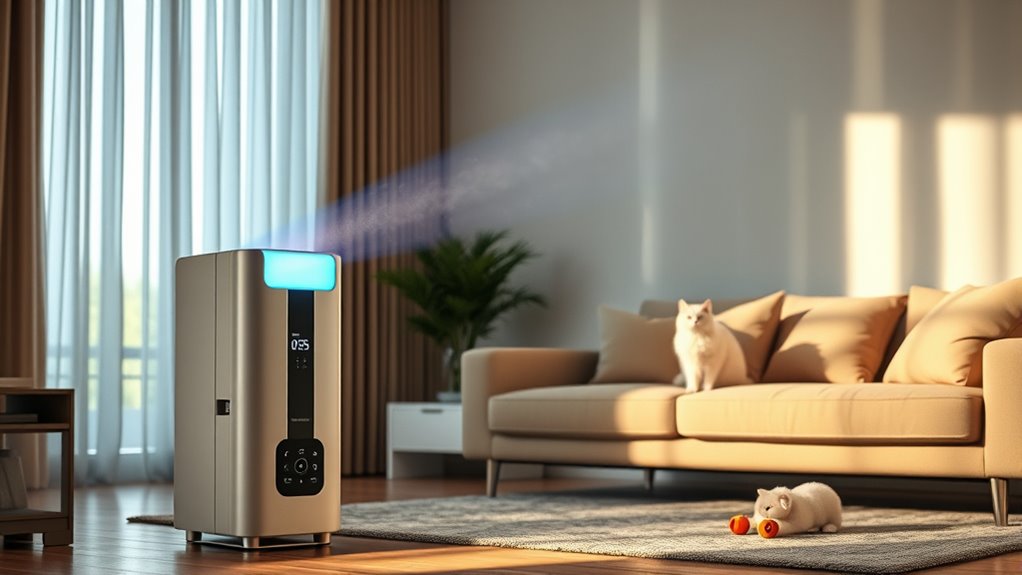
Selecting the right air purifier can make a noticeable difference in controlling pet dander. When comparing models, look for units with HEPA filters, as they effectively trap pet hair removal and airborne allergens. Some purifiers also include activated carbon filters to reduce odors and allergen particles. Consider the size of your space; larger rooms require higher-capacity purifiers for ideal results. Pay attention to CADR ratings—higher numbers indicate better air cleaning performance. Additionally, choose a model with features like auto mode or air quality sensors to enhance allergen avoidance techniques. Quiet operation is also important if you plan to run it continuously in bedrooms or living areas. By selecting a suitable air purifier, you improve air quality and reduce pet dander, making allergy relief more achievable.
Maintenance Tips to Keep Your Air Purifier Working Effectively

To keep your air purifier working effectively, regular maintenance is essential. First, replace the filter as recommended—usually every 3 to 6 months—to ensure maximum dander removal. Second, perform device cleaning regularly by wiping down the exterior and air intake vents to prevent dust buildup. Third, check the pre-filter (if applicable) and clean or replace it as needed to maintain airflow. Proper filter replacement and device cleaning prevent reduced efficiency and prolong your purifier’s lifespan. Always follow the manufacturer’s instructions for specific maintenance schedules. Keeping your air purifier in top shape ensures it continues to effectively reduce pet dander and improve indoor air quality. Regular upkeep is the key to consistent performance and a healthier environment.
Real-Life Experiences: Improving Indoor Air Quality With Air Purifiers
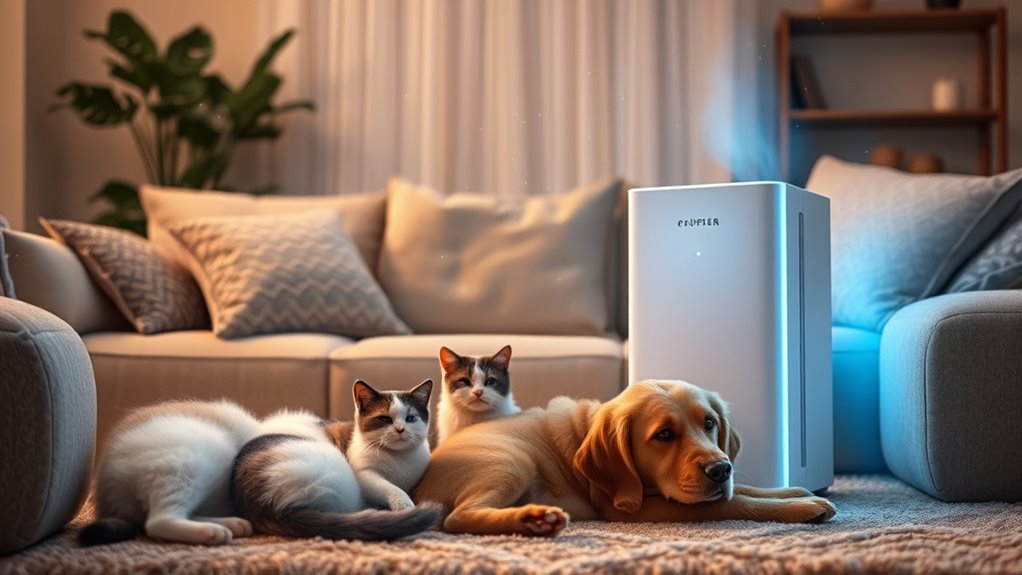
Many pet owners have seen firsthand how air purifiers can transform indoor air quality, especially for households dealing with allergies or asthma. After regular pet grooming, you notice less dander floating in the air, making a difference. Air purifiers help capture pet hair, dander, and other allergens, reducing symptoms and improving breathing. Some pet owners who relied on allergy medication found they needed less once they used an air purifier consistently. They also share that keeping their living space well-ventilated and using air purifiers has made managing pet allergies more manageable. These real-life experiences show that combining pet grooming practices with the right air purifier can markedly improve indoor air quality and comfort in your home.
Frequently Asked Questions
Can Air Purifiers Completely Eliminate Pet Allergies Indoors?
You wonder if air purifiers can fully eliminate pet allergy triggers indoors. While they substantially reduce pet dander and improve air quality, they can’t completely eliminate all allergy triggers. Regular air purifier maintenance is essential to keep it effective. Remember, combining air purifiers with regular cleaning and grooming helps minimize pet allergies, but you might still experience some symptoms. So, they’re helpful, but not a total solution.
How Often Should I Replace Filters in My Pet Allergy Air Purifier?
A stitch in time saves nine, so don’t ignore filter lifespan. You should check your air purifier’s manual for recommended replacement frequency, generally every 3 to 6 months. This guarantees peak performance and keeps pet dander at bay. Regularly replacing filters prevents buildup and maintains air quality. Keep an eye on filter indicators or signs of reduced airflow, and replace filters promptly to breathe easier indoors.
Are There Specific Brands Recommended for Pet Dander Removal?
When choosing an air purifier for pet dander, you want reliable brand recommendations that focus on filter maintenance. Brands like Dyson, Honeywell, and Blueair are known for their high-quality filters that effectively trap pet allergens. Regular filter replacement is key to maintaining performance, so check the manufacturer’s guidelines. Investing in a reputable brand guarantees you get an air purifier that keeps your air clean and allergen-free over time.
Do Air Purifiers Remove Pet Odors in Addition to Dander?
Did you know that around 70% of pet owners struggle with pet odors? Air purifier effectiveness extends beyond dander removal; many models also help with pet odor removal. While they won’t completely eliminate strong smells, high-quality air purifiers with activated carbon filters markedly reduce pet odors, making your home more comfortable. So, yes, an air purifier can help manage both pet dander and odors, enhancing your living space.
Can Air Purifiers Help With Pet Allergies in Large Open Spaces?
In large spaces, air purifiers can help with pet allergies by improving air circulation and removing pet dander. You should choose a high-capacity purifier designed for bigger areas, ensuring it runs continuously to filter airborne allergens effectively. Proper placement is key—position it where airflow is strongest. While it won’t eliminate all allergens, it markedly reduces dander, making the environment more comfortable for allergy sufferers.
Conclusion
By choosing the right air purifier and using it correctly, you can considerably reduce pet dander and breathe easier at home. It’s like turning your living space into a sanctuary of pure, fresh air, free from the sneezing and itching. Don’t underestimate the power of a good air purifier—it’s your secret weapon against pet allergies. Take control today and transform your home into a haven where you can finally relax and enjoy your furry friends without discomfort.
